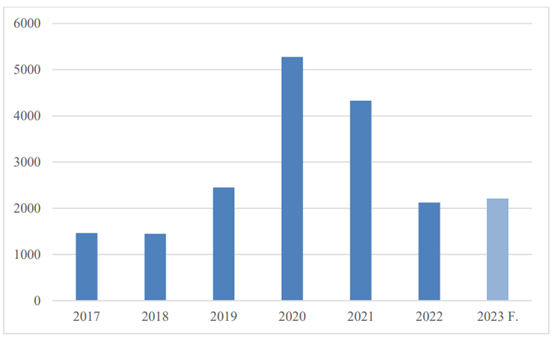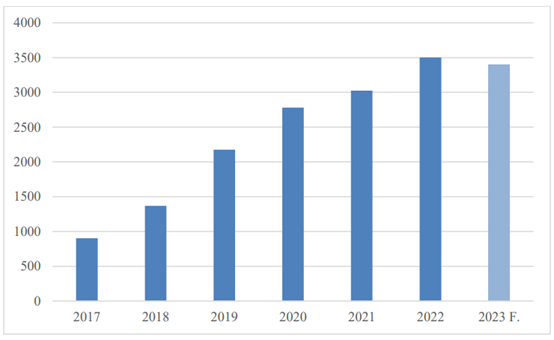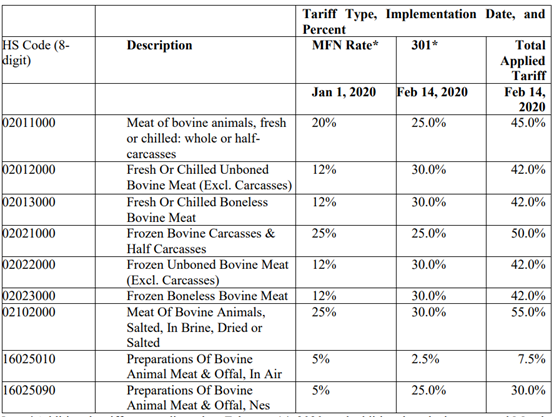The People's Republic of China (PRC) decision to end its zero-COVID policy restrictions is expected to improve demand for both pork and beef products in 2023. However, Brazil's decision to suspend beef exports to China at the end of February following a suspected bovine spongiform encephalitis (BSE) detection could impact supply as alternative origin suppliers may not fully bridge the potential supply gap in 2023. Pork production and imports, and beef production are all forecast to grow in 2023. Hong Kong remains the PRC's primary export market for pork and beef.
Hog Imports: Imports of live breeding swine in 2023 are forecast at 5,000 head due to large domestic sow inventories. In early 2023, the domestic sow inventory exceeded China's Ministry of Agriculture and Rural Affairs (MARA) targets. A large domestic sow inventory is expected to curb imports of breeding swine.
Pork Imports: In 2023, pork imports are expected higher by nearly 4 percent YOY to 2.2 MMT on stronger consumer demand following the end of COVID restrictions, but further growth will be curbed by higher domestic production.
Cattle Imports: Cattle imports in 2023 are forecast to decline to 270 thousand head from 350 thousand in 2022 due to a large cattle inventory and supplier-initiated export prohibitions.
Beef Imports: Beef imports in 2023 are forecast slightly lower at 3.4 MMT. In February 2023, Brazil self-suspended beef exports following the detection of a suspected BSE case. If the suspension endures and no other alternate origin suppliers materialize, beef prices could move higher and negatively impact beef consumption in 2023.
Policy: Since the last FAS China GAIN report covering the PRC pork and beef sector, the country has ended its COVID controls on imported cold chain products.
TRADE
Imports
Live Hog Imports to Remain Unchanged from 2022
In 2023, hog imports are unchanged from 2022 at 5,000 head due to a large domestic sow herd. Significant herd expansion is not expected due to sufficient domestic supplies and government policies aimed at a stable sow inventory.
In 2023, the major live hog suppliers are expected to remain the United States, France, and Denmark.
Pork Imports to Grow Together with Pork Production
Pork imports are expected to increase 4 percent YOY to 2.2 MMT. In 2020 and 2021, China's pork imports reached historically high levels as production contracted due to ASF. In 2022, as production recovered, imports declined by 51 percent but remained just over 2.1 MMT. In 2023, with stronger consumer demand pork imports are expected to exceed 2022 levels.
Chart 1. China: Imports of Pork Products (Unit: 1,000 MT)

Source: Trade Data Monitor
Cattle Imports to Further Decline
Cattle imports in 2023 are forecast to decline to 270 thousand head from 350 thousand in 2022 due to a large herd and high input costs. Buyers mainly import from New Zealand, Australia, Uruguay, and Chile. Live beef cattle imports are mainly used to improve beef cattle herd genetics. New Zealand and Australia mostly export dairy cattle while Uruguay and Chile mainly export beef cattle. As announced in July 2021, New Zealand will cease exports of livestock by sea by April 30, 2023, which will lower the supply of available cattle imports unless the PRC provides market access to other suppliers.
Beef Imports Growth Uncertain
The beef imports forecast for 2023 is lowered to 3.4 MMT due to Brazil's self-suspension of exports in February 2023. Brazil is China's number one beef exporter of frozen boneless beef products. Beef imports may also be curbed by traders' excess inventory from last year.
Demand for imported beef products is expected to be stronger in 2023 following the lifting of COVID restrictions. Frozen beef imports (bone and boneless) accounted for nearly 98 percent of China's total imports in 2022. Chilled and fresh beef, dominated by the United States, Australia, and New Zealand is expected to grow in 2023. The removal of COVID testing, disinfection, and segregation policies, which added significant costs and delays to imported and cold chain products is expected to facilitate trade, particularly in fresh and chilled products.
Brazil, Argentina, Uruguay, New Zealand, Australia, and the United States are expected to remain to be the dominant beef suppliers. Over the last three years, exports of beef products from the United States to the PRC grew rapidly after market access was regained. Beef exports from the United States are expected to continue to grow in 2023 as traders and consumers become more familiar with the specific U.S. cuts and beef quality.
In 2023, beef imports from Australia could witness growth if the bilateral relationship between the PRC and Australia improves. Under the China-Australia Free Trade Agreement Australian beef exports receive a preferential tariff quota under which the tariff rate has dropped to 1.2 percent in 2023.
Beef imports in 2022 are revised to 3.5 MMT with 16 percent growth YOY according to available trade data.
Chart 2. China: Beef Imports (Unit: 1,000 MT)

Source: Trade Data Monitor and Post Estimates
CONSUMPTION
Pork
Consumption to Grow from Improved HRI Demand
In 2023, pork consumption is increased to nearly 57.6 MMT due to improved demand from the HRI sector following the end of the PRC's zero-COVID restrictions. In December 2022, the PRC relaxed COVID restrictions in the HRI sector and on domestic and international travel. The PRC also removed COVID testing requirements for imported cold-chain products. These changes are expected to boost consumer demand for restaurants and hotels and allow schools and companies to resume full operations. However, recovery in the HRI sector is expected to be gradual.
Overall pork consumption in 2023 is expected to marginally increase from a relatively high 2022 base year. Demand for pork products, through retail and HRI, is expected to strengthen in 2023, boost prices, and support stronger consumption of pork products. At the end of 2022 and beginning of 2023, China faced a surge in COVID infections across the country lowering demand for pork products. Additionally, industry sources reported that the endemic ASF outbreaks during the winter months may have caused panic selling and slaughter which increased supply and lowered pork prices. Due to these and other factors, prices remained low at the beginning of 2023.
Beef
Beef Consumption Impacted by Brazil's Suspension of Beef Exports
In 2023, domestic beef consumption is expected to reach 10.8 MMT, only a marginal increase over 2022 rates, impacted by lower beef imports in 2023. At the end of February 2023, Brazil self-suspended beef exports to the PRC due to a suspected BSE case in northern Brazil. If the suspension endures and no other alternate origin suppliers materialize, beef prices could move higher and negatively impact beef consumption in 2023.
Demand from the HRI sector is expected to recover gradually as consumption resumes following the end of COVID restrictions. Additionally, the PRC government may institute policies to boost economic activity, which are expected to support increased consumption, including beef consumption. However, as many food service and HRI establishments closed in 2022 due to prolonged COVID restrictions, it will take time for normal operations to resume.
In 2022, despite the prolonged COVID restrictions, beef consumption grew by 7 percent. This indicates that continued beef consumption growth can be expected as the PRC's per capital beef consumption is much lower than major beef consuming countries.
Beef consumption is concentrated in affluent, large cities in eastern and southern China. Popular beef cuts in China include high quality muscle cuts for hot-pot, barbeque, and high-end restaurants. In 2023, beef consumption areas and product types are expected to remain similar.
POLICY
PRC Removes COVID-19 Testing and Disinfection Measures
On December 28, 2022, the General Administration of Customs of the People's Republic of China (GACC) published Announcement No. 131 of 2022, changing COVID-19 controls and management. The Announcement ended PRC-required testing and disinfection measures for COVID-19 on imported cold-chain foods and non-cold chain goods effective January 8, 2023. The announcement removed the PRC's non-science based COVID testing and disinfection measures.
Local industry welcomed the removal, noting the change should reduce costs and improve clearance times. The PRC had issued earlier requirements for testing and disinfection through GACC Announcement No. 58 of 2022 and emergency measures in GACC Announcement No. 103 of 2020.
No additional COVID restrictions are expected. Additionally, the removal of restrictions is expected to boost demand in the HRI sector.
Removal of Registration for Foreign Trade Operators
The requirement for foreign trade operators to register at local commercial authorities has also been removed effective since December 30, 2022. Market entities that apply for import and export permits, quotas, and state trading enterprises will no longer be required to provide a registration record.
Retaliatory Tariffs on U.S. products
The tariff exclusion process introduced by the State Council Tariff Commission (SCTC) in March 2020 remains in effect. The program allows importers to apply for tariff exclusions from China's Section 301 retaliatory tariffs on U.S. products, including pork and beef products.
However, the exclusion process does not apply to China's retaliatory Section 232 tariffs. U.S. pork products are among certain agricultural products that are still subject to China's Section 232 retaliatory tariffs.
Table 1. China: Tariff Schedule on U.S. Pork Products

Table 2. China: Tariff Schedule on U.S. Beef Products

Source: USDA
Note: This article is compiled by Antion, please indicate our source if reprint it.